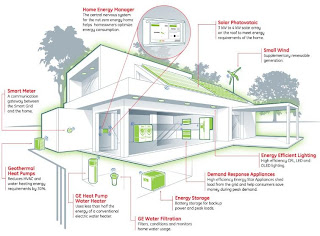Zero Energy Building Scheme
A zeronet energy building (ZNE) is a popular term to describe a buildings use with zero net energy consumption and zero carbon emissions annually.
ZeroNet Energy buildings can be used autonomously from the energy grid supply – energy can be harvested on-site usually in combination with energy producing technologies like Solar and Wind while reducing the overall use of energy with extremely efficient HVAC and Lighting technologies. The ZeroNet design principle is becoming more practical in adopting due to the increasing costs of traditional fossil fuels and their negative impact on the planet's climate and ecological balance.
The ZNE consumption principle is gaining considerable interest as renewable energy harvesting as a means to cut greenhouse gas emissions. Traditional building use consumes 40% of the total fossil energy in the US and European Union. In developing countries many people have to live in zero-energy buildings out of necessity. Many people live in huts, yurts, tents and caves exposed to temperature extremes and without access to electricity. These conditions and the limited size of living quarters would be considered uncomfortable in the developed countries.
The most cost-effective steps toward a reduction in a building's energy consumption usually occurs during the design process. To achieve efficient energy use, zero energy design departs significantly from conventional construction practice. Successful zero energy building designers typically combine time tested passive solar, or natural conditioning, principles that work with the on site assets. Sunlight and solar heat, prevailing breezes, and the cool of the earth below a building, can provide daylighting and stable indoor temperatures with minimum mechanical means. ZEBs are normally optimized to use passive solar heat gain and shading, combined with thermal mass to stabilize diurnal temperature variations throughout the day, and in most climates are superinsulated. All the technologies needed to create zero energy buildings are available off-the-shelf today. Sophisticated 3D computer simulation tools are available to model how a building will perform with a range of design variables such as building orientation (relative to the daily and seasonal position of the sun), window and door type and placement, overhang depth, insulation type and values of the building elements, air tightness (weatherization), the efficiency of heating, cooling, lighting and other equipment, as well as local climate. These simulations help the designers predict how the building will perform before it is built, and enable them to model the economic and financial implications on building cost benefit analysis, or even more appropriate - life cycle assessment.
Zero-Energy Buildings are built with significant energy-saving features. The heating and cooling loads are lowered by using high-efficiency equipment, added insulation, high-efficiency windows, natural ventilation, and other techniques. These features vary depending on climate zones in which the construction occurs. Water heating loads can be lowered by using water conservation fixtures, heat recovery units on waste water, and by using solar water heating, and high-efficiency water heating equipment. In addition, daylighting with skylites or solartubes can provide 100% of daytime illumination within the home. Nighttime illumination is typically done with fluorescent and LED lighting that use 1/3 or less power then incandescent lights, without adding unwanted heat. And miscellaneous electric loads can be lessened by choosing efficient appliances and minimizing phantom loads or standby power. Other techniques to reach net zero (dependent on climate) are Earth sheltered building principles, superinsulation walls using straw-bale construction, Vitruvianbuilt pre-fabricated building panels and roof elements plus exterior landscaping for seasonal shading.
Zero-energy buildings are often designed to make dual use of energy including white goods; for example, using refrigerator exhaust to heat domestic water, ventilation air and shower drain heat exchangers, office machines and computer servers, and body heat to heat the building. These buildings make use of heat energy that conventional buildings may exhaust outside. They may use heat recovery ventilation, hot water heat recycling, combined heat and power, and absorption chiller units.

Tidak ada komentar:
Posting Komentar